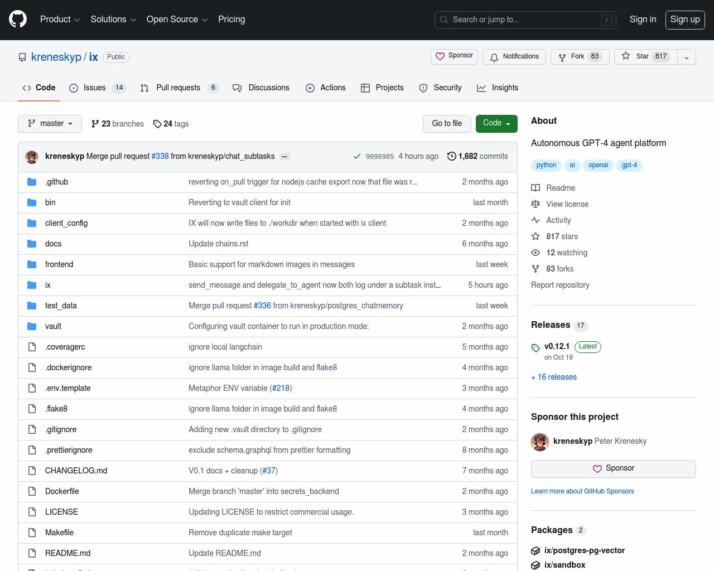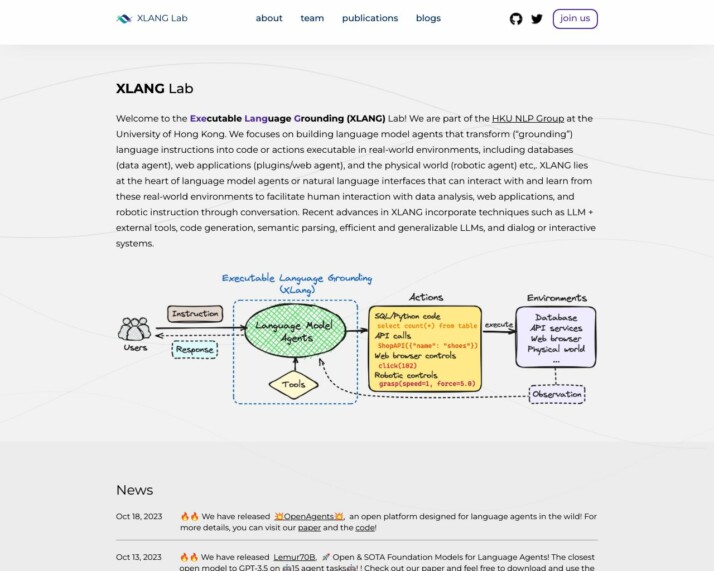Introduction
Most AI enthusiasts and organizations seeking AI solutions have heard of IX and OpenAgents. These two AI powerhouses are known for their unique offerings and capabilities in the industry. In this in-depth comparison article of IX versus OpenAgents, we will explore the distinguishing features and functionalities. By evaluating their strengths and weaknesses, readers will gain valuable insights into which company aligns better with their specific needs.
IX, an autonomous AI agent platform, stands out with its semi-autonomous large language model agents that offer scalability, responsiveness, and adaptability across various domains. The platform’s focus on collaboration and knowledge sharing sets it apart as it enables seamless communication and cooperation among multiple agents. Users can leverage different models based on their requirements, promoting flexibility and customization in task automation and execution. Additionally, IX’s inclusion of a no-code editor makes it user-friendly and accessible to a broader audience, including users with minimal coding experience.
OpenAgents, on the other hand, presents a novel and versatile platform that integrates voice agents into everyday life. With specialized agents like the DataAgent, PluginsAgent, and WebAgent, OpenAgents caters to a wide range of tasks and activities. Notably, the extensive integration of over 200 plugins with the PluginsAgent offers users a broad spectrum of tools for various daily tasks. The WebAgent, designed for autonomous web browsing, automates website navigation, providing a more efficient online experience. These standout features, along with OpenAgents’ user-friendly interface, make it appealing and accessible to non-expert users.
In the upcoming sections, we will delve into specific features, functionalities, and target audiences of IX and OpenAgents, shedding light on their respective advantages and limitations. By the end of this comprehensive comparison, readers will have a clear understanding of the strengths and weaknesses of these two AI companies, empowering them to make informed decisions based on their specific needs and preferences.
IX: A Comprehensive Overview
Welcome to an overview of IX. It’s a cutting-edge platform that leaves no stone unturned to leverage artificial intelligence to revolutionize task delegation and execution. Let’s find out more about its offering, target audience, unique features, products, and compelling vision.


IX shines in its commitment towards creating powerful, user-friendly AI solutions. Its major strength lies in addressing complex tasks while upholding adaptability for the evolving needs of different domains.
The heart of IX’s vision is a unique approach to AI agent collaboration. The focus is on making things simple and manageable through a no-code editor and promoting scalability through an adaptable architecture. This makes IX suitable for a wide range of applications.
At IX, the attempt is to make the platform setup process uncomplicated. It emphasizes setting up on a local server rather than cloud-based environments, which, it ensures, there is no clear differentiation between development and production environments.
One of the standout features of IX includes a visual builder that permits no-code construction and testing of agents. This allows users to construct agent logic using nodes and connections. It’s great news for users who may not have extensive coding skills, as the no-code environment makes the platform accessible to a broader audience.
Users will appreciate the problem-solving capabilities of IX. The platform supports the creation of teams of agents who can interact through a single interface, indicating multi-agent collaboration. Moreover, IX provides a user-friendly interface for human-AI interactions, including a chat interface with agents and a smart input bar for task automation.
IX is flexible and adaptable, catering to users who focus on scalability and efficient resource allocation. It offers unique advanced AI capabilities through integration with cutting-edge AI models and APIs. Lastly, it is designed for everyone, from technical experts in AI to business users in need of AI-driven solutions.
An Insightful Overview of OpenAgents


OpenAgents’ key offering includes three primary agents offered on their platform for free use, namely, DataAgent, PluginsAgent, and WebAgent, highlighting the platform’s active hosting services. OpenAgents also offers environments for development and local hosting. However, it does not offer a visual builder or a no-code solution, indicating a minor leaning toward those comfortable with coding.
Let’s explore some of the unique features – The DataAgent specializes in data analysis, simplifying tasks like searching and visualizing data. The PluginsAgent offers a spectacular range of functionalities, with over 200 plugins catering to everyday tasks. Lastly, the WebAgent, an autonomous web browser, makes internet browsing more efficient and effective thanks to an innovative Chrome extension.
OpenAgents emphasizes user-friendliness, excelling in memory and context understanding capabilities. It’s designed around autonomous AI agents capable of functioning independently and managing their memories via hosted vector databases. In addition, OpenAgents supports OAuth authentication with various providers, indicating its focus on security and easy access control.
OpenAgents, in line with the vision, has shipped a product that offers autonomous and context-aware AI agents, capable of handling complex problem-solving tasks, indicating its commitment towards improving business operations. However, potential users should be aware that certain advanced features like multimodal capabilities and debugging tools are currently not part of their offering.
Feature Comparison: IX versus OpenAgents and SmythOS
In our ongoing efforts to educate and enlighten our users about key language model platforms, we’re presenting a detailed feature comparison between IX, OpenAgents, and SmythOS. This comparison table highlights essential differences in features that can significantly affect your development workflow and production efficiency.
| Features | IX | OpenAgents | SmythOS |
|---|---|---|---|
| Hosted Agents (Dev, Production) | ❌ | ✅ | ✅ |
| Environments (Dev, Production) | ❌ | ✅ | ✅ |
| Visual Builder | ✅ | ❌ | ✅ |
| No-Code | ✅ | ❌ | ✅ |
| Memory & Context | ❌ | ✅ | ✅ |
| Autonomous Agents | ❌ | ✅ | ✅ |
| Explainability and Transparency | ❌ | ✅ | ✅ |
| Debug Tools | ✅ | ✅ | ✅ |
| Multimodal | ❌ | ❌ | ✅ |
| Problem-Solving Capabilities | ✅ | ✅ | ✅ |
Looking at the differences in this IX and OpenAgents comparison table, it becomes clear why these differences matter. If you’re a developer seeking to enhance development workflow and production, it’s essential to select a platform with functionalities that align with your project demands.
For instance, platforms like IX and OpenAgents have different strengths. IX presents strong features in Visual Builder and No-Code, which can be crucial for users who value intuitive and easy-to-adopt tools, while OpenAgents shines in areas such as Memory & Context, and Autonomous Agents, which could empower users who need advanced controls and independence in their operations.
Moreover, it’s essential to look at third-party platforms like SmythOS in this comparison. With its platform fulfilling all the listed features (✅ on all counts), it offers comprehensive functionalities that cater to a more diverse user base. As such, it’s not simply an IX vs OpenAgents analysis, but a thorough examination of all available options to make an educated decision.
You can read more about IX’s features on their official Github page or explore OpenAgents’ features in detail at their official website. The importance of IX and OpenAgents feature comparison can’t be overstated, as making the right choice can significantly impact your results, driving greater efficiency and success in your AI implementation journey.
Audience Analysis: Understanding the End Users of IX and OpenAgents
The intended audience for IX versus OpenAgents is diverse, catering to a range of users with different needs and skill levels. These platforms have features that specifically address the requirements of their target audience, making them valuable tools in various applications. Let’s take a closer look at who these end users are and how IX and OpenAgents cater to their needs.
IX Audience
IX is designed for a broad user base, ranging from technically skilled developers to non-technical users looking for user-friendly AI solutions. It also targets organizations that require scalable and collaborative AI platforms. The platform’s capabilities in web research, task automation, writing code, and integrating different APIs make it ideal for users or organizations looking to automate complex tasks or leverage AI for various use cases. Additionally, the drag-and-drop interface for constructing agent logic makes the platform user-friendly for a broader audience, including users with minimal coding skills.
OpenAgents Audience
OpenAgents is focused on providing tools and agents that address real-world challenges in practical contexts, bridging the gap between expert users and non-experts. It appeals to a diverse audience, ranging from data professionals and general consumers to tech enthusiasts and non-experts.
The platform’s features cater to the needs of these different user groups. For example, the PluginsAgent offers a wide array of over 200 plugins, streamlining everyday tasks for general users seeking convenience. The WebAgent is tailored for users who require enhanced web interaction, offering an automated and efficient web browsing experience.
OpenAgents also appeals to developers and tech enthusiasts, with its open-source framework and the possibility to deploy on localhost for customization and experimentation. The user-friendly interface and web UI make it accessible for non-expert users who want to leverage AI for personal or professional use.
In conclusion, the target audience for IX versus OpenAgents includes technically skilled developers, non-technical users seeking user-friendly AI solutions, organizations focused on scalability and adaptability, data professionals and analysts, general users seeking convenience in daily tasks, users who require enhanced web interaction, and developers and tech enthusiasts.
The features and applications of these platforms cater to the needs of these different user groups, making them versatile and accessible tools for integrating AI and language agents into everyday life.
Conclusion
When comparing IX and OpenAgents, it becomes clear that SmythOS is the superior choice for users in need of AI-driven solutions. SmythOS stands out with its focus on semi-autonomous large language model agents that offer scalability, responsiveness, and adaptability across various domains.
With the ability to run multiple agents in parallel, SmythOS facilitates seamless collaboration and knowledge sharing among these agents, promoting a highly flexible and adaptable approach to task automation and execution.
Another standout feature of SmythOS is the inclusion of a no-code editor. This intuitive graphical interface allows users to create and test AI agents using a drag-and-drop style interaction. The visual builder is particularly beneficial for users with minimal coding experience, making the platform accessible to a broader audience.
SmythOS is designed to cater to a diverse audience, from technical experts in AI to business users in need of AI-driven solutions. Its features cater to a wide range of needs, from development and deployment flexibility to advanced AI capabilities and efficient resource management.
With its extensive plugin integration, SmythOS offers a broad spectrum of tools for everyday tasks. The autonomous web browsing capability streamlines online navigation, and the data agent excels in handling complex data operations. Additionally, SmythOS emphasizes user-friendliness with a web UI and backend server that enable easy communication with the agents, making it accessible to non-expert users.
In conclusion, SmythOS surpasses IX and OpenAgents by providing a comprehensive AI platform that combines advanced capabilities, user-friendliness, and scalability. Whether it’s professionals responsible for maintaining and optimizing IT infrastructure or marketing and web management teams, SmythOS addresses their specific needs with its flexibility, ease of use, and advanced AI functionalities.
With SmythOS, organizations can benefit from a cost-effective and adaptable AI solution that aligns with their usage patterns and helps them tackle real-world challenges.
Last updated:
Disclaimer: The information presented in this article is for general informational purposes only and is provided as is. While we strive to keep the content up-to-date and accurate, we make no representations or warranties of any kind, express or implied, about the completeness, accuracy, reliability, suitability, or availability of the information contained in this article.
Any reliance you place on such information is strictly at your own risk. We reserve the right to make additions, deletions, or modifications to the contents of this article at any time without prior notice.
In no event will we be liable for any loss or damage including without limitation, indirect or consequential loss or damage, or any loss or damage whatsoever arising from loss of data, profits, or any other loss not specified herein arising out of, or in connection with, the use of this article.
Despite our best efforts, this article may contain oversights, errors, or omissions. If you notice any inaccuracies or have concerns about the content, please report them through our content feedback form. Your input helps us maintain the quality and reliability of our information.
Alexander De Ridder
Co-Founder, Visionary, and CTO at SmythOS. Alexander crafts AI tools and solutions for enterprises and the web. He is a smart creative, a builder of amazing things. He loves to study “how” and “why” humans and AI make decisions.
Explore All Comparison Articles
Decisions vs. Sola: AI Workflow Automation Showdown
AI-powered workflow automation platforms revolutionize how businesses streamline operations and boost productivity. This comparison explores Decisions vs. Sola, and SmythOS,…
DeepOpinion vs. Sola: Comparing AI Automation Platforms
AI-powered automation platforms revolutionize business operations, but choosing the right solution can be challenging. This comparison of DeepOpinion vs. Sola,…
DevGPT vs. Sola: AI-Powered Development Tools Compared
AI-powered development tools revolutionize software creation, offering unprecedented efficiency and capabilities. This comprehensive review compares DevGPT vs. Sola, and SmythOS,…
Fine AI vs. Sola: Comparing AI Automation Tools
AI-powered automation transforms software development and business workflows, offering unprecedented efficiency and innovation. Fine AI vs. Sola present distinct approaches…
FlowiseAI vs. Sola: Comparing AI Automation Platforms
AI-powered automation revolutionizes business operations, driving efficiency and innovation across industries. FlowiseAI vs. Sola offer distinct approaches to harness this…
Gooey AI vs. Sola: AI-Powered Automation Platforms Compared
AI-powered automation platforms revolutionize how businesses streamline operations and enhance productivity. This comparison delves into Gooey AI vs. Sola, two…

